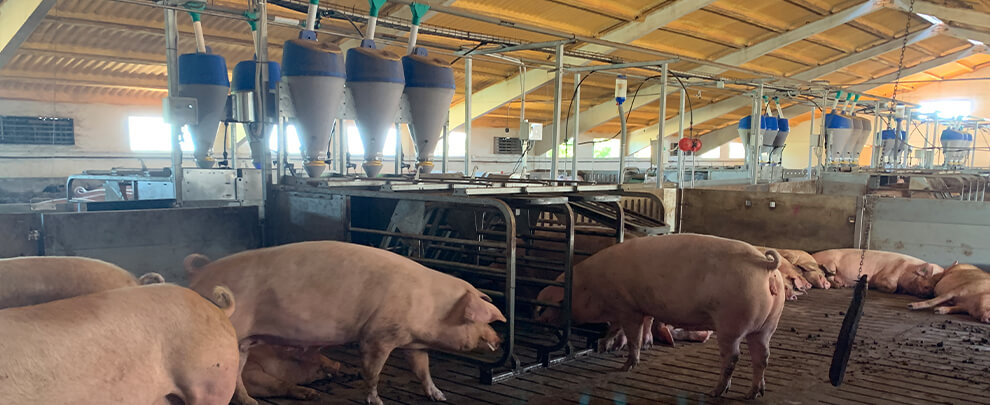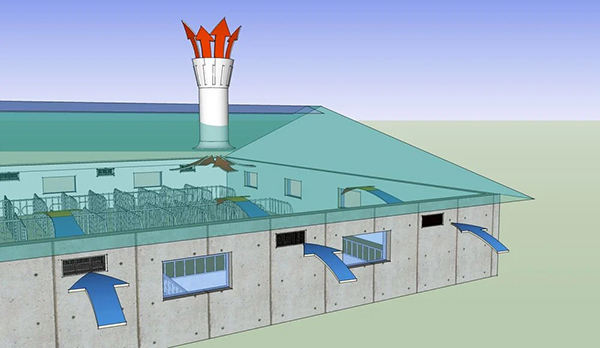Blog
Blog

Keys to climate control in gestation
22nd October 2024 - Studies
Marcel Weiss Hoffmann. Munters Business Area
Gestation is a critical period in swine production. The effective management of the ventilation has a profound impact on the success of a swine operation. As swine production has improved, the importance of optimal conditions in gestational facilities has become increasingly apparent. This article explore some aspects of climate control in gestation, and also discusses the economic benefits and return on investment (ROI) associated with these systems. In addition, we will emphasize the importance of planning, selecting appropriate equipment and the role of trained professionals in developing and maintaining quality climate control systems.
The importance of climate control in gestation barns
Climate control in gestation barns is an essential factor of current swine production. The environment inside these barns directly influences the health, comfort, and productivity of pregnant sows. When the climate isn't properly managed, it could result in stress, diseases and poor reproductive results, all of which negatively affect the profitability of the operation.
This production section animals are specifically sensitive to their environment. They have specific needs for temperature, humidity, and air quality that must be met to make certain they continue to be healthful and productive throughout their gestation. Failure to maintain an optimal environment can result in a range of problems, such as decreased feed consumption, poor body condition, lower conception rates, smaller litter sizes, and increased susceptibility to disease.
Temperature Regulation
Temperature is a primary concern when managing the environment in gestation barns. Sows thrive within a specific temperature range, known as the thermoneutral zone, which typically falls between 16°C and 21°C for gestating sows. Keeping the barn within this range is critical for minimizing stress and promoting healthy pregnancies.
Cold stress: When temperatures fall below thermoneutral zone, sows expend more energy to maintain their body temperature. This can lead to more feed is used for warmth rather than for growth and fetal development. In addition, cold stress can weaken the immune system, making animals more susceptible to disease.
Heat stress: On the other hand, high temperatures can cause heat stress, which can reduce feed intake, resulting in poor body condition and small litter sizes. It can also increase the risk of early embryonic loss, compromising overall reproductive performance.
Efficient heating and cooling systems can be required to maintain optimal temperatures. This may include the use of heaters or forced-air systems during colder months and fans, evaporative cooling pads in warmer periods.
Ventilation
Ventilation systems are designed to remove excess moisture, heat, and harmful gases such as ammonia and CO2 while ensuring a continuous supply of fresh air. Effective ventilation requires careful planning and control of the ventilation in barn. This involves the strategic placement of air inlets and exhaust fans to ensure even distribution of air. Proper ventilation can prevent the development of hot spots and cold spots. The design of the barn should be considered in the project to ensure that all animals receive optimum ventilation and stay in proper temperature. The ventilation system must be able to ensure that the swine´s are comfortable at all levels of ventilation, from the minimum, when the outside temperature is very low, to the maximum temperature, when the outside temperature is hot. It should maintaining the animals within the conform zone, without causing stress from temperature or air drafts.

Image of a ventilation installation in progress. Photo: Munters.
Economical Advantages
Investing in climate control systems in gestation barns is not just about animal welfare; It also has major economic impact. Effective climate control can lead to significant cost savings, increased productivity, and more profitable operations. Below, we examine the main economic benefits of implementing a climate control system.
Improved reproductive performance: One direct economic benefit of climate control is its impact on reproductive outcomes. If swine’s are maintained in ideal conditions, they are more likely to exhibit a more consistent estrous cycle, have higher pregnancy rates, and produce larger, healthier litters Reduced heat or cold stress leads to better body condition, which is crucial for sustaining pregnancy and producing healthy piglets. Also preparing the animal for the farrowing.
Enhanced feed efficiency: Proper climate control leads to better feed efficiency, as sows demand less energy for thermoregulation. When sows are in their thermoneutral zone, they utilize feed more efficiently, converting it into growth and reproductive output rather than merely maintaining body temperature. This reduces feed costs, which are a significant expense one of the costs of production.
Reduced Veterinary Costs: A well-controlled climate reduces the incidence of respiratory diseases and other health issues associated with poor air quality or temperature extremes. Healthier pigs mean lower veterinary costs, fewer treatment , and less downtime due to illness. Preventing diseases through effective climate control is more cost-effective than treating sick animals.
Energy Savings: While the initial installation of climate control systems can represent a a significant amount of money, the percentage of the cost on the total project is small. The equipments will be used for many years , resulting in a low cost per Kg/produced and often result in significant energy savings over time. Modern systems are designed to be energy-efficient, using sensors and automated controls to optimize the use of heating, cooling, and ventilation. This can lead to substantial reductions in energy bills, especially in regions with extreme climates.
Longevity of Equipment and Facilities: Maintaining a stable environment in gestation barns can also prolong the life of equipment and materials. Excessive humidity or temperature fluctuations can cause damage to building materials and mechanical systems, leading to more frequent repairs and replacements. Investing in climate control, farmers can protect their products and reduce long-term maintenance costs.
Return on Investment (ROI)
When considering the use of climate control systems, it is important to consider the potential return on investment (ROI). While the upfront costs of installing these systems can be significant, the long-term economic benefits often outweigh the initial investment. The increase in productivity, improved feed efficiency, reduced veterinary costs, and energy savings all contribute to a positive ROI.
For example, the enhanced reproductive performance resulting from a well-controlled climate leads to more piglets born per sow, directly increasing revenue. Additionally, the improved feed efficiency and reduced veterinary costs lower overall operating expenses, further boosting profitability. Over time, these factors can lead to a significant return on the initial investment in climate control systems.






